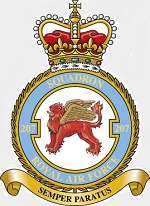Hobby Master HA4610 RAF Lockheed-Martin F-35B Lightning II Joint Strike Fighter - ZM151, No.207 Squadron, RAF Marham, Norfolk, England, 2019 [Low-Vis Scheme] (1:72 Scale)
"The F-35 program executive officer, has stated that the 'F-35 enjoys a significant Combat Loss Exchange Ratio advantage over the current and future air-to-air threats, to include Sukhois, which are currently being flown by the Russian, Indian, and Chinese Air Forces.'"
- Maj Gen Charles R. Davis, USAF, the F-35 program executive officer
 The Lockheed Martin F-35 Lightning II is a fifth-generation, single-seat, single-engine, stealth-capable military strike fighter, a multirole aircraft that can perform close air support, tactical bombing, and air superiority fighter missions. The F-35 has three different models; one is the conventional takeoff and landing variant, the second is short takeoff and vertical-landing variant, and the third is a carrier-based variant.
The Lockheed Martin F-35 Lightning II is a fifth-generation, single-seat, single-engine, stealth-capable military strike fighter, a multirole aircraft that can perform close air support, tactical bombing, and air superiority fighter missions. The F-35 has three different models; one is the conventional takeoff and landing variant, the second is short takeoff and vertical-landing variant, and the third is a carrier-based variant.
The F-35 is descended from the X-35, the product of the Joint Strike Fighter (JSF) program. Its development is being principally funded by the United States, with the United Kingdom, and other partner governments providing additional funding. It is being designed and built by an aerospace industry team led by Lockheed Martin with Northrop Grumman and BAE Systems as major partners. Demonstrator aircraft flew in 2000, with the first flight on December 15th, 2006.
The F-35B Lightning II is the Marine Corps variant of the Joint Strike Fighter and features a vertical lift fan and pivoting engine nozzle to deliver vertical landing and short takeoff capability to expeditionary airfields. The F-35 will replace AV-8B Harrier IIs in the Marine Corps inventory.
Designed to operate from austere bases and a range of air-capable ships with its short takeoff/vertical landing capability, the F-35B can also takeoff and land conventionally from longer runways on major bases. F-35B aircraft have been delivered to the U.S. Marines and the U.K., whose forces are training together at the Integrated Training Center at Eglin Air Force Base. STOVL aircraft are also stationed at the first operational F-35 base, Marine Corps Air Station Yuma, Ariz., and are completing flight test at Naval Air Station Patuxent River, Md. The Italian Air Force will also operate the B-variant. The F-35B has a Lift Fan just behind the cockpit and an engine that can swivel 90 degrees when in short takeoff/vertical landing mode. Because of the Lift Fan, the STOVL variant has smaller internal weapon bay and less internal fuel capacity than the F-35A. It uses the probe and drogue method of aerial refueling.
Pictured here is a 1:72 scale replica of a Royal Air Force Lockheed-Martin F-35B Lightning II Joint Strike Fighter attached to No.207 Squadron, which is deployed to RAF Marham, Norfolk, England, during 2019.
Sold Out!
Dimensions:
Wingspan: 5-3/4-inches
Length: 8-1/2-inches
Release Date: March 2020
 Historical Account: "Always Prepared" - Number 207 Squadron is an historic bomber squadron and, latterly, a communications and flying training squadron of the Royal Air Force, most recently based at RAF Linton-on-Ouse in Yorkshire, operating Short Tucano T.1 trainer aircraft.
Historical Account: "Always Prepared" - Number 207 Squadron is an historic bomber squadron and, latterly, a communications and flying training squadron of the Royal Air Force, most recently based at RAF Linton-on-Ouse in Yorkshire, operating Short Tucano T.1 trainer aircraft.
It was announced on July 5th, 2017, that No.207 Squadron will again reform to become the Operational Conversion Unit for the UK F-35B Lightning Force and will return to RAF Marham in Norfolk where it was last based in 1965. No.207 Squadron arrived at RAF Marham with six F-35Bs on July 16th, 2019, before officially standing up on August 1st.
General characteristics Crew: 1 - Length: 51.4 ft (15.67 m)
- Wingspan: 35 ft (10.7 m)
- Height: 14.2 ft (4.33 m)
- Wing area: 460 ft (42.7 m)
- Empty weight: 29,300 lb (13,300 kg)
- Loaded weight: 44,400 lb (20,100 kg)
- Max takeoff weight: 70,000 lb (31,800 kg)
- Powerplant: 1 Pratt & Whitney F135 afterburning turbofan
- Dry thrust: 28,000 lbf (125 kN)
- Thrust with afterburner: 43,000 lbf[256] (191 kN)
- Internal fuel: 18,480 lb (8,382 kg)
- Performance
Maximum speed: Mach 1.67 (1,283 mph, 2,065 km/h) - Range: 1,200 nmi (2,220 km) on internal fuel
- Combat radius: 610 nmi (1,110 km) on internal fuel
- Service ceiling: 60,000 ft (18,288 m)
- Rate of climb: classified (not publicly available)
- Wing loading: 91.4 lb/ft (446 kg/m)
- Thrust/weight:
With full fuel: 0.84; - With 50% fuel: 1.04 B:
- g-Limits: 9 g
- Armament
Guns: 1 GAU-22/A 25 mm (0.984 in) cannon internally with 180 rounds - Hardpoints: 6 external pylons on wings with a capacity of 15,000 lb (6,800 kg) and 2 internal bays with 2 pylons each[60] for a total weapons payload of 18,000 lb (8,100 kg) and provisions to carry combinations of:
- Missiles:
Air-to-air: AIM-120 AMRAAM, AIM-132 ASRAAM, AIM-9X Sidewinder, IRIS-T - Air-to-ground: AGM-154 JSOW, AGM-158 JASSM
- Bombs:
Mark 84, Mark 83 and Mark 82 GP bombs - Mk.20 Rockeye II cluster bomb
- Wind Corrected Munitions Dispenser capable
- Paveway-series laser-guided bombs
- Small Diameter Bomb (SDB)
- JDAM-series
- B61 nuclear bomb (in 2017)
- Avionics
Northrop Grumman Electronic Systems AN/APG-81 AESA radar - Differences across variants
- ^ B is the same, C: 14.9 ft (4.54 m)
- ^ C is same, B: 60,000 lb (27,000 kg)
- ^ F-35B: 14,003 lb (6,352 kg); F-35C: 20,085 lb (9,110 kg)
- ^ F-35B: 7.5 g, F-35C: 7.5 g
- ^ fitted as an external pod with 220 rounds in the F-35B and F-35C
Wingspan: 5-3/4-inches
Length: 8-1/2-inches
|


